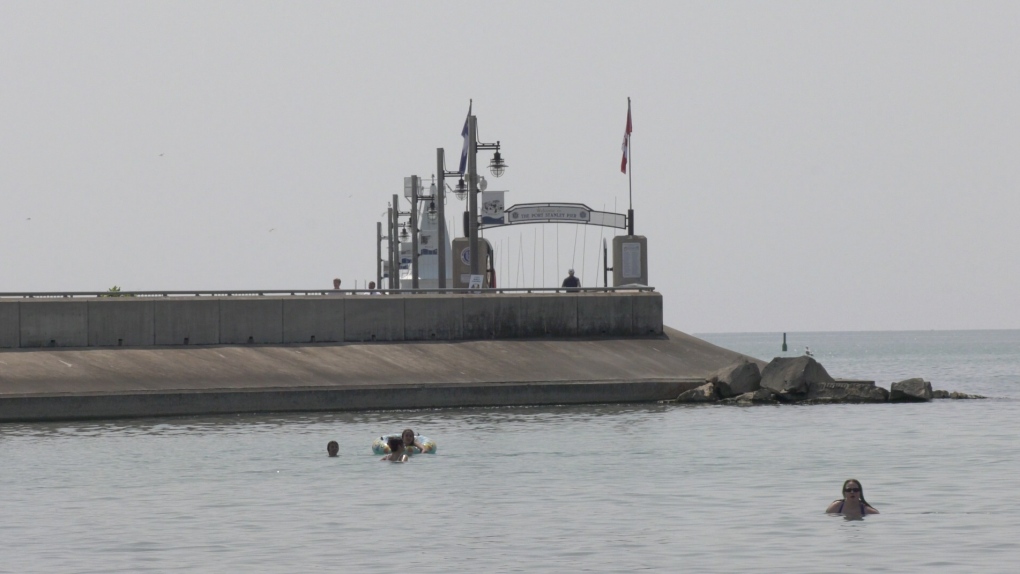When chaos begins and tragedy happens: water safety experts warn of rip currents at Port Stanley
It was a bittersweet occasion Tuesday, as Elgin County raised a flag at its administration building to recognize Drowning Prevention Week.
It comes on the heels of a drowning in Port Stanley just over a week ago.
On July 14, a 14-year-old boy went missing while swimming near the pier. His body was pulled from the water two days later. Seventeen year old Ella Pys of Cambridge was on the beach with her family the day he disappeared. She was back at the beach Tuesday, the tragic event still on her mind.
“It was like scary because I know like it could have been me or the people I was with. But it was like, I don’t know, just really sad for the family,” she said.
Nathan McIntyre is a member of the Elgin County Drowning Prevention Coalition, and a former board member of the Great Lakes Water Safety Consortium. He says people specifically need to be aware of rip currents, which form around structures, and occur on windy days.
 Port Stanley Pier (Bryan Bicknell/CTV News London)
Port Stanley Pier (Bryan Bicknell/CTV News London)
“With the break wall and the pier here the water will become trapped on the shoreline. The water volume then increases on the shoreline. And as everyone knows, water, with gravity, needs to find its own equilibrium. And it needs to return to the lake, and it will however it wants to. What we’re noticing is that often, that return is an outflow of water that we refer to now as a rip current,” McIntyre explained.
Briar McCaw, who co-chairs the Elgin County Drowning Prevention Coalition, said that water safety is a collective responsibility.
“Just because you are in a supervised setting, which obviously does increase safety, but you still have to take your own precautions and educate yourself on the waterfront, and your friends and family. I think it’s a collective measure that we all have to be responsible for,” she said.
The World Health Organization now classifies a non-fatal drowning as a drowning.
According to the Drowning Prevention Coalition, there are 450 fatal drownings in Ontario every year, but an estimated four to five times as many non-fatal drownings.
Those in the business of saving lives say don’t take a chance with Mother Nature, especially when windy conditions are causing rip currents.
“If you get stuck in a rip-current it’s going to take you out into deeper water,” said McIntyre. “It’s in that moment an individual is going to try to swim against that current. They’re going to get tired out and they’re going to find themselves in deeper water. That’s when chaos begins and that’s when tragedy happens,” he warned.
CTVNews.ca Top Stories

Calgary woman stranded in Mexico after husband's death during diving trip
A Calgary woman is struggling to return home after her husband died while diving in Mexico, leaving her stranded and facing financial hardship.
Fugitive U.S. rioter seeks asylum in Whistler amid warnings of more to come
An American citizen convicted of participating in the Jan. 6, 2021, riot on Capitol Hill and dodging jail time in Whistler may just be the start of an asylum-seeking rush, according to a prominent legal expert.
Special national Liberal caucus meeting called for next week after regional chairs meet: sources
A special meeting of Prime Minister Justin Trudeau's national Liberal caucus has been called for next Wednesday, sources say.
N.S. community shocked by deaths of father, daughter; suspect was wanted in Toronto shooting
A Nova Scotia community is mourning the loss of two of its members after they were shot and killed in Halifax on New Year's Eve.
Canada pausing applications for parent, grandparent permanent residency sponsorships
Canada will not accept new parent and grandparent permanent residency sponsorship applications until further notice, according to a ministerial directive.
Soldier who blew up Tesla at Trump hotel left note saying blast was to be a 'wakeup call' for the U.S.
A highly decorated Army soldier who fatally shot himself in a Tesla Cybertruck just before it blew up outside the Trump hotel in Las Vegas left notes saying the New Year's Day explosion was a stunt to serve as a “wakeup call” for the country’s ills, investigators said Friday.
Sea and Himalayan salts recalled in Canada: 'Do not use, serve or distribute'
Two brands of sea and Himalayan salt are being recalled in Canada due to pieces of plastic found in the products.
'Inadmissible' foreign nationals to pay more upon return to Canada: CBSA
Foreign nationals who refuse or are unable to pay their own way home after being denied stay in Canada will soon face steeper financial penalties should they ever attempt to return.
'It's about time': Experts in Canada support call for warnings about cancer risk from alcohol
While Canada hasn't mandated cancer warnings for alcoholic beverages, a few experts are supporting a new push in the U.S. to have the labels on the products.

































